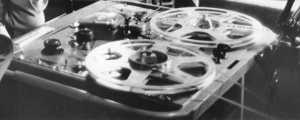From the “Dr Who” Publicity photograph.
Len Shorey
I like the tape loop on the pick up spool!
Adrian Stocks ‘Yogi Bear’ – was forever making them to compensate for the lack of machinery. Once , on visiting his control room during lunch break he had a tape loop so long it looked like a washing line.
Mike Jordan
That is like International Control Room (ICR) in the early satellite/standards converter days when audio/and video could get out of sync (particularly on satellite delivered programmes when sometimes audio went terrestrially): they had a big (adjustable for length) tape loop across the room to add delay.
Not a lot changes really though. When I was EMing “The Priory” and we had remotes at peoples houses, rather than send the c/f by the satellite, I used to ensure it went by a bit of copper (possibly) phone line so that at least the punter got minimal time delay and the presenter (should) be able to cope with the incoming delays.
Pat Heigham
I remember a heath-robinson device that deviated the audio tape between the record and playback heads on a TR90 deck – an arrangement of rollers that pulled the tape out from the normal path, around a remote roller and back to the normal route before the playback head. The remote roller could be tweaked in and out via a screw thread adjustment, to get the sound in sync with the vision delay.
VT
Alec Bray, Peter Neill
There was a David Jacobs pilot phone-in programme – must be in the 1963 – 1968 timeframe It was called “Hotline”, produced by one Stewart. Morris
The (General) Post Office would not allow live phone-ins, and, in any case, and there was always the worry about unsuitable material being broadcast – so the answer was to introduce a delay using VT.
I went down to VT to see the setup: one VT Machine was recording the show, and then there was about 15 feet of 2-inch tape strung across the area between machines to another VT machine which was doing the playback to air. Some equivalent technology to the prompt cut was used to cut the Transmission of the playout machine.
Chris Booth
Full explanation as far as we remember at www.vtoldboys.com/hotline.htm
Jeff Booth
There were also several delays applied when (for example) “Grandstand” missed the start of an F1 Grand Prix due to previous event over-running. I recall 6 VTRs (1") recording, rewinding, syncing with the machine ‘on air’, going on air before the previous recording ran out, etc. etc.
Those were the days. No servers, no automation (maybe a pinball machine) but never a brown trouser in sight.
The Pinball machine – otherwise known as a timecode offset box: this was a box containing three timecode displays – VTR1, VTR2 and the difference between the two. A row of zeroes meant you were in sync. Lots of plugging, but great fun.
Alasdair Lawrance
I once heard of a similar arrangement for the Grand National at Aintree, because of contractual problems re live coverage.



